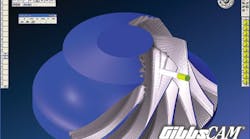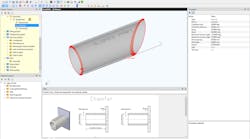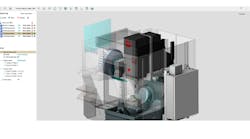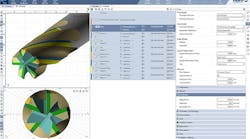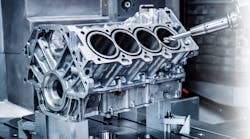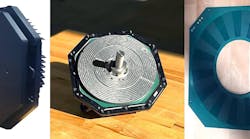Gibbs and Associates is shipping the latest version of its CNC machine programming software, GibbsCAM 2010. “We have been working very hard to provide customers new functionality across the GibbsCAM product family,” said Bill Gibbs, founder and president. “We added many capabilities to make programming and machining easier and more efficient, especially with new features in 5-axis and solids machining.”
The 2010 update to GibbsCAM delivers what founder and president Bill Gibbs calls “new functionality across the GibbsCAM product family,” including capabilities to make programming and machining easier and more efficient, especially for 5-axis and solids machining.
He continued: “We also implemented 64-bit operation to enable faster processing of long programs and complex parts, added support for new tools and tool holders, extended functionality within various modules, and extended and updated interoperability with various CAD systems,” according to Gibbs.
5-Axis Functionality
For 5-axis machining, the new GibbsCAM offers several programming improvements, including: more spiral machining options; new gouge-check projection options; a new lead in/lead out “flip” option; a new axial shift damp option for trimming applications; and support for countersink and keyway cutters.
More specific additions are:
- Geometry Creation – A plug-in function will create surfaces for repairing or improving machinability of surfaces from solids.
- Adaptive Cuts – This new option lets programmers regulate the distance between paths based upon the angle of the surface to be machined, to provide a consistent surface finish, regardless of surface angle.
- Impeller Roughing – This function has been enhanced with functionality to cover more contingencies, which GibbsCAM says will e “especially useful when roughing near and around splitter blades.”
- Tool Retraction – A new option — “Retract Through Tube Center” — will make it possible to retract” cutting tools from angled pockets while avoiding walls, especially useful for machining cylinder head ports and similar geometry,” the developer said.
Machining Solids
In addition, GibbsCAM 2010 offers a series of enhanced capabilities for machining solids. Among these:
Plunge Roughing – This option has been upgraded from a plug-in tool and now appears as a tile in the CAM palette. So, programmers can calculate material removal strategies that accommodate carbide-inserted drills, which require special motion for no-drag retractions, and avoiding collisions.
Advanced 3D Machining– Among these enhancements are Hit Flats, with specified tools for Pocketing, which makes it possible to specify flatness tolerance in Flats Cut. This ensures that all desired “flat” areas are machined, locking in high feed rate for Shortest Route and Minimal Vertical retract styles.
Option for Stock– Facet bodies, generated from a previous machining process, or brought in through a data file, can be used now as initial stock in solid pocketing.
64-bit Implementation
GibbsCAM calls 64-bit implementation a “significant development” that lets programmers take advantage of more powerful, multi-processor PCs equipped with 4GB or more of RAM. This provides tighter interoperability with 64-bit CAD systems that are co-resident with GibbsCAM on a PC; and, 64-bit operation reduces computation time when processing very long programs or working with complex geometry.
Also, it will let users take advantage of system enhancements when running under the Windows 7 operating system.
The developer said other new features to GibbsCAM 2010 have been installed to simplify use or to extend functionality, including enhancements to the user interface and for the Milling, MTM (multi-task machining) and Wire EDM modules, and new add-ins for data exchange to support Inventor 2010, SolidWorks 2010, and additional CAD file import and translation. Furthermore, the Macros menu was enhanced to make access easier, with uninterrupted operation, and to support 5-axis, Advanced 3D processes, and calls to plug-ins.
